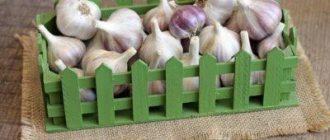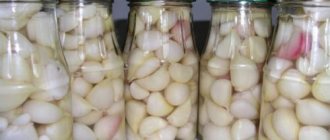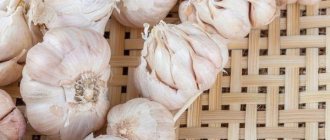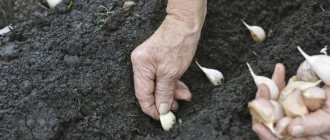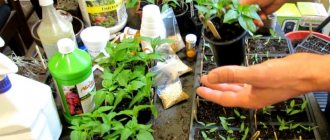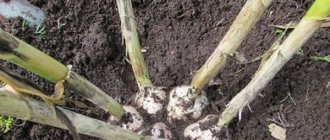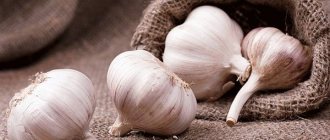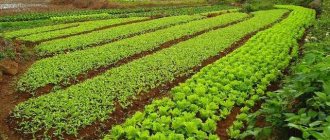Rules for applying fertilizers for garlic
The development of any plant, including garlic, occurs in stages. First, there is active growth of the aboveground part - leaves and stems. During this period, garlic requires nitrogen, which stimulates the growth of greenery.
Nitrogen-containing fertilizers are: manure and bird droppings, urea (urea), infusion of green grass. Solutions are applied to the root zone of garlic after watering the beds with clean water.
At the moment of bulb formation, the plant needs another set of elements - potassium and phosphorus, microelements (zinc, magnesium, iron, boron). They are “responsible” for the growth of roots, the formation of a large, full-fledged head, its ripening and subsequent good storage. The crop is no longer fed with nitrogen so as not to stimulate further growth of garlic tops to the detriment of bulb formation.
Fertilizers that will be required to feed garlic during the head filling period:
- wood ash;
- superphosphate;
- potassium salt;
- potassium sulfate;
- iodine tincture;
- set of microelements.
Fertilizing is carried out both by direct watering of the plant at the root and by spraying the leaves with an aqueous infusion of fertilizer.
Proper feeding for the season
Winter garlic is planted in the fall, and the harvest is obtained from it earlier than from spring garlic. Both species need feeding. However, winter crops still require autumn feeding.
in autumn
Before applying fertilizers, you need to take into account that garlic is sensitive to changes in soil acidity. If you plant garlic according to the rules, then you should begin preparing the beds 1–2 weeks before the expected planting date. Some gardeners use ready-made compounds, while others prepare fertilizers themselves. The following substances are used as autumn feeding:
- 1 bucket of humus;
- 1 tbsp. l. double superphosphate;
- 2 tbsp. l. potassium sulfate;
- 0.5 liters of wood ash.
In the autumn, nitrogen fertilizers are not applied. The need for them arises in early spring, as soon as the snow melts. They ensure the active development of the root system and the growth of the above-ground part.
Garlic responds very well to fertilizing with wood ash.
in spring
With the arrival of spring, winter garlic begins to sprout and needs feeding. As a rule, it is carried out 6–10 days after the snow melts. As for the spring crop, it is fed a little later, when active growth of the stems begins.
Garlic does not like waterlogging, so fertilizing should be done in conjunction with watering.
The first spring replenishment is carried out using urea (1 tablespoon) diluted in 10 liters of water. Water the garlic bed with the prepared solution at the rate of 2–3 liters per 1 m². After 2 weeks, a second feeding is carried out, both spring and winter garlic. The main ingredient in this case is nitrophoska or nitroammofoska. You will need to dilute 2 tbsp. l. per 10 liters of water and spend 3–4 liters per 1 m².
Video: spring feeding of garlic
In summer
The next feeding occurs in mid-June. During this period, the formation of the head and the increase in its mass begin. Accordingly, the plant needs additional nutrition. The timing of fertilizing for spring and winter garlic is approximately the same, but it is worth considering that the winter crop ripens earlier. Therefore, you need to adhere not only to deadlines, but also pay attention to how the plants develop.
If fertilizers are applied ahead of schedule, the stems and arrows will begin to develop rapidly, and at a later date, nutrition will be useless.
In order for large heads of garlic to form, it is necessary to use phosphorus-potassium fertilizers. Therefore, fertilizing involves the addition of the following substances:
- 30 g superphosphate;
- 15 g potassium sulfate;
- 10 liters of water.
The finished solution will be enough to fertilize a bed with an area of 2 m². If desired, you can replace potassium sulfate with wood ash at the rate of 200 ml of ash per 10 liters of water.
How often can you feed garlic?
During the entire period of growing the crop, from germination to harvesting, garlic is fed 2-4 times. The amount of fertilizing depends on the initial fertility of the soil and the application of fertilizers during planting and on the prevailing weather.
- In case of low fertility (the soil is depleted and has a sandy structure), garlic is fed 4 times: twice during the active growth of greenery and twice during the formation of the head.
- If the summer is rainy, nutrients from the soil are washed out more actively, so fertilizing will also have to be done more often than usual.
- On fertile loamy soil, with the addition of a full range of fertilizers to the soil before planting garlic, you can limit yourself to two feedings.
When to feed garlic in June 2022 according to the lunar calendar
The lunar calendar is considered an assistant to every summer resident. Contains the necessary nutrients for rapid growth and weight gain of the head.
Favorable days for feeding garlic in June 2022 according to the lunar calendar
Feeding according to the lunar calendar should be June 2, 11-12, 16-17, 21-24, 29. However, these numbers do not guarantee a large harvest, and each summer resident selects the time of application of fertilizers independently.
Unfavorable time
Days when it is recommended to refrain from any actions in relation to garlic are considered unfavorable. In June 2022, such numbers are considered to be 3, 5, 15, 25.
How to feed garlic in June so that the heads are large
The main elements that the plant requires are nitrogen, potassium and phosphorus. Receiving these elements in an easily digestible form, the plant produces a large, full-fledged head. A visually healthy and “well-fed” plant has a thick, powerful stem and long, bright green leaves. Small size, small foliage and yellowed tops indicate a lack of nutrition or garlic disease.
Mineral fertilizers
A gardener can find ready-made fertilizer formulations on sale, especially for onions and garlic. Nutrients are selected in the concentration and ratio that best suits the plant.
The following complex fertilizers for garlic are popular among gardeners:
- Fusco (ratio of nitrogen, phosphorus and potassium 8:8:12);
- Fasco is a complex prolonged fertilizer containing magnesium and calcium;
- Agros (contains nitrogen, phosphorus, potassium, iron, magnesium, calcium, boron);
- Buy fertilizers (OMU for onions and garlic);
- Agricola;
- Fertika.
The finished complex fertilizer is dissolved in water in the dose indicated in the instructions, and the garlic is watered at the root.
In addition to ready-made mixtures, you can use individual mineral compositions. To feed garlic in June, superphosphate (or double superphosphate), potassium sulfate, and potassium sulfate are used.
To prepare a nutrient solution, dissolve the following in a bucket of lukewarm water:
- 2 tbsp. level spoons of superphosphate or 1 tbsp. a spoonful of double superphosphate;
- 1 tbsp. a spoonful of potassium sulfate or potassium sulfate.
Water the garlic at the root, spending about 1 liter per plant.
Advice. If garlic needs “first aid” with fertilizing, spray the foliage with a nutrient composition. The working solution is made 2 times weaker than for watering at the root. Plants are sprayed in the evening or in cloudy weather. Through the foliage, nutrition is more likely to penetrate to the plant cells.
Organic compounds
Garlic reacts positively to feeding with humus and aqueous solutions of manure. This fertilizer contains mainly nitrogen, so it is applied in the spring and June.
Humus vegetable or rotted manure
Compost or humus is prepared from plant residues, vegetable peelings, tops of garden plants and mowed weeds. The raw materials are placed tightly in heaps and spilled with water and a solution of the Baikal preparation. The remaining liquid food waste is also poured onto the heap.
To speed up the preparation of humus, the pile is covered with black film. Ready compost is considered to be black, with a uniform crumbly structure and a pleasant smell of forest soil.
Cattle manure is also placed in a dense pile to rot, in order to change the structure of the product. Manure that has lain in a heap for at least 3 years is suitable for feeding garlic.
Humus or manure is scattered between the rows of garlic, mulching the soil surface in a layer of 3-5 cm. This mulch, gradually dissolving from irrigation water, nourishes the roots of the plant without burning them.
Infusion of chicken droppings or manure
Liquid manure extract acts faster on garlic and can be regarded as an “ambulance” for a plant experiencing nitrogen deficiency.
1 kg of chicken manure is poured into 10 liters of water and left to infuse for several days. To prepare the working solution, take 1 liter of infusion and dilute it with 9 liters of clean water.
1 kg of mullein is stirred in a bucket of warm water and left for 24 hours. Fertilizer concentrate for watering garlic is diluted with water 5 times.
Consumption of nutrient solution – 10 l per 1 sq. m of bed area.
Important! Fresh manure and droppings cannot be used to feed garlic! This will cause burns to the roots and foliage of the plant, and it may die.
At the beginning of summer, an infusion of green herbs will be a useful supplement for garlic. It will saturate the soil with nitrogen and other elements and will help the gardener if the compost is not yet ripe. Prepare the infusion like this:
- Finely chopped fresh herbs are placed in a suitable container, filling it three-quarters full. Any vegetation is suitable: weeds, meadow grass, vegetable tops. In May, young succulent nettles grow a lot in vacant lots and along ravines - an excellent raw material for “green manure”.
- The barrel is filled to the top with warm water and left to ferment in a warm place for a week.
- It is useful to stir the mixture during cooking.
- To reduce the unpleasant smell of rotting grass, add the drug Baikal (1 liter per 100 liters of infusion) or valerian tincture to the infusion.
Before use, the finished infusion is diluted with clean water in a ratio of 1 to 7.
On a note. Some gardeners, to enhance the effect, add wood ash (1 kg per 200 liter barrel) and chicken manure (2 kg per barrel) to the herb infusion.
Infusions of manure and grass are poured over the garlic at the roots, being careful not to get on the foliage.
Folk remedies
To fertilize garlic in June, gardeners who are adherents of organic farming use ash, yeast or crackers, and ammonia. Such fertilizers do not harm the environment; their overdose will not cause serious harm to plants.
Ash
This product serves to feed garlic with potassium, phosphorus, and microelements. Only ash from burning wood, hay, and straw is suitable.
You cannot use ash from plastic, painted wood, or printed materials because of the heavy metals it contains.
Ash can be sprinkled on the soil around the plants, using 1 cup of powder per 1 square meter. m or prepare an ash infusion: 2 cups of ash are poured into 8 liters of water at a temperature of 40-45 degrees. They insist for 2 days. Before watering, filter and dilute with plain water, bringing the volume of the solution to 12 liters. Infusion consumption is 0.5 l per plant.
Ash: super remedy for garlic. Care in June for a big harvest - video
Yeast or bread
A nutritious infusion that helps increase the mass of garlic heads.
Take 1 kg of crackers or 2 tbsp for a bucket of warm water. spoons of baker's yeast. The mass is infused in a warm place for 12 hours, with frequent stirring. The prepared infusion is poured over the garlic once, at the moment the head forms.
Ammonia
A preparation containing ammonia not only feeds garlic with nitrogen, but also strengthens the plant’s immunity. Add no more than 40 g of ammonia per 10 liters of water. It is better to apply fertilizing by spraying.
As a top dressing with microelements, garlic is often sprayed with a pink solution of potassium permanganate.
What to use for fertilizing
Before planting garlic, as well as during its cultivation, the soil is fertilized with both organic and mineral substances.
Organic fertilizers and folk remedies
Garlic responds very well to the addition of organic matter, which is especially important on depleted soils. Sometimes one autumn feeding is enough, which will provide the plants with the necessary nutrition during the growing season. The most popular organic fertilizer is manure, which is applied for digging. Some gardeners use fresh material, but experts still recommend adding humus (rotted manure). If bird droppings are used, it must also be introduced carefully, since an excessive amount can simply burn the shoots.
Humus is added to the garlic bed during autumn digging
In spring, the crop needs strength to grow. For these purposes, you can prepare a solution based on mullein (1 part fertilizer to 7 parts water). Water the garlic bed with the solution, avoiding liquid getting on the stems. To enrich the soil with nutrients, it is quite appropriate to use compost.
Compost is an organic fertilizer that is obtained as a result of the decomposition of organic residues (plants from the garden, foliage, peat, manure, straw, etc.).
A fairly common organic supplement for garlic is mullein infusion.
The most common folk remedy for fertilizing garlic is wood ash. It can be applied either in dry form, by sprinkling between rows, or in the form of a solution (200 g per 10 liters of water). In addition to ash, gardeners use salt, for which a solution of 3 tbsp is prepared. l. salt per 10 liters of water. Also common means include ammonia, which is used to spray garlic (25 ml of ammonia per 10 liters of water).
Mineral fertilizers
Fertilizing of a particular crop is carried out to replenish nutrients in the soil. When using only organic components, it is not always possible to achieve a balance of nutrients. The choice of fertilizers and their quantity depends on the fertility of the soil. Among the most common mineral supplements, the following are used:
- urea (1 tbsp per 10 liters of water);
- nitroammophoska (60 g per 10 liters of water);
- superphosphate (50–60 g per bucket of water);
- urea (1 tbsp per bucket of water);
- nitrophoska (2 tbsp per bucket of water).
To make the nutrient solution more effective, it is recommended to combine some components. So, when nitrogen and phosphorus (1:1.5) are introduced into the soil, the greens will develop better, and nutrients will accumulate in the head.
Garlic can be fed not only with organic matter, but also with mineral fertilizers
After rain or watering, it is quite appropriate to apply fertilizer in dry form. The composition can be as follows: nitrogen, phosphorus, potassium (in a ratio of 8:15:35). To determine the amount and composition of fertilizers, you need to take into account a number of important factors:
- How fertile is the soil on the site and what is its acidity;
- climatic features of the region (precipitation, frost);
- illumination of the area;
- predecessors of garlic (the best predecessor crops are grains and zucchini);
- crop variety (ripening time, conditions for growth and development).
To determine soil acidity, special probes or devices are used. In accordance with the indications, the soil is deoxidized or, conversely, the acidity is increased. For garlic, you need to select an area with neutral and fertile soil.
Video: how to feed garlic so that the heads are large
How to feed garlic in June to prevent it from turning yellow
There are three reasons why garlic leaves turn yellow:
- lack of nitrogen;
- excess or lack of moisture;
- presence of harmful insects.
An infusion of chicken manure, green grass, a solution of urea (1 tablespoon of powder per 10 liters of water) or spraying plants with ammonia will help to compensate for the lack of nitrogen.
Kinds
There are many fertilizers, but only some of them are suitable for garlic. Types of fertilizers:
- Saline solution is necessary for growth. It helps to overcome a disease that causes the leaves and stems of the plant to turn yellow and dry. Treatment with a salt solution helps get rid of pests. To prepare 3 tbsp. l. salts are thoroughly mixed in 10 liters of water.
- Wood ash helps garlic become saturated with nutrients and treat the soil against pests. It is used in the summer in a liquid solution: June and July. To prepare, 200 g of ash is diluted in 10 liters of water. Sometimes plants are powdered.
- Ammonia is a double assistant for the gardener; it destroys pests and saturates plants with nitrogen. 25 ml of ammonia are diluted in 10 liters of water, and the plantings are sprayed with it.
- Chicken manure is applied before planting in the fall. The main thing is not to use it fresh. Garlic loses its taste and ability to be preserved for a long time.
- Mullein is used throughout the growing season. Prepare a liquid solution. Manure and water are placed in a bucket in a ratio of 1:5. The mixture should stand for about 2 weeks. From time to time it is opened and stirred. The finished solution is diluted with water in a ratio of 1:10 and then watered. For 1 m² you will need from 8 to 10 liters.
Organics enrich with vitamins, preventing the formation of nitrates. Fertilizing increases the yield and taste buds of this crop.
What does it depend on?
Feeding the plant depends on:
Seasons . In the spring, garlic needs nitrogenous fertilizing (to build up green mass), in the summer fertilizer helps the growth and formation of a large and strong head, in the fall - in order to survive the winter and sprout in early spring.- From plant growth phase:
- During hibernation (autumn). Fertilizer is applied so that the plant can survive the winter and sprout in the spring.
- The period of growth of green mass (spring). During this phase, garlic needs additional nutrition. As a rule, 2 feedings are carried out with a break of 2 weeks. Fertilizing is carried out using nitrogen fertilizers.
- The period of head formation (summer). For the formation of garlic heads, potassium-phosphorus fertilizers are required.
- It depends on what type of fertilizer is used by the summer resident . You can only use organic fertilizers (manure, compost, wood ash, yeast, salt), but you can also use mineral fertilizers (purchased in a special store).
Features of caring for garlic in May, June and July
In addition to fertilizing, regular watering is required to form large heads. The soil in May, June and July must be constantly maintained in a moderately moist state. Mulching the beds will help with this.
When the weather is hot enough, the bed is watered once every 3-4 days, soaking the substrate 20-30 cm deep. The next day (it doesn’t matter whether watering is carried out in May, June or July), the soil in the garlic bed needs to be processed - loosened so that it does not “cake” into a hard crust that does not allow air to pass through, and if necessary, weed.
For garlic in June, both “drought” and constant waterlogging of the soil are harmful.
Garlic planted before winter, with proper fertilizing, already begins to form “arrows” in June. To prevent them from taking away nutrients from the heads, they need to be trimmed. A few “arrows” are left only if it is planned to use the “bulbs” for reproduction.
Important! Spring garlic does not form arrows either in June or later. The quality of fertilizing does not affect this, the only exception is the Gulliver variety.
When and how often to fertilize
Most gardeners prefer to plant winter garlic. Therefore, the main feeding scheme for this crop is designed specifically for it. Fertilizers begin to be applied almost immediately after the snow melts and continue until the end of the active growing season. You should not skip the stage of head formation in May-June.
Typically, garlic planted before winter, if the bed has been properly prepared, requires three feedings per season:
- At the very beginning of the active growing season, when seedlings appear (the first half of April).
- Approximately 15-20 days after the first feeding (late April or early May).
- At the stage of head formation (mid-June).
The seedlings are fed in early spring to stimulate the growth of green mass.
The crop responds well to both natural organic matter and store-bought mineral or organomineral fertilizers. Feeding with folk remedies is also acceptable.
But it must be taken into account that at different stages of development the needs for macro- and microelements change. At the beginning of the growing season, nitrogen is mainly needed to increase green mass. The developing heads require phosphorus and potassium in May and June.
Additional fertilizing is also acceptable, usually foliar in June-July. The deficiency of certain microelements can be judged by the condition and appearance of the plant. For example, dry white tips on garlic leaves in June are a sign of potassium deficiency.
Features of onion fertilizer
There are several features of feeding onions.
Feeding onions on feathers occurs in the following sequence:
- the first feeding is with ammonium nitrate (suitable, among other things, for feeding winter onions);
- the second - a week later - with a mixture of potassium chloride (10 g) and superphosphate (30 g) per 10 liters of water.
There is another simple recipe for using wood ash to feed onions. Take 200 grams of ash and mix with 10 liters of water. Insist for 2 days. After the mixture has infused sufficiently, add carefully crushed laundry soap in the amount of 300 g. Stir.
Among organic fertilizers, herbal infusion is used for the second feeding of onions. To prepare such an infusion, the herbs are crushed (any weed will do) and the herb is soaked in water. Place under a small weight to allow fermentation to begin. For application, use diluted liquid to a light brown tint.
There may be a need for additional feeding of onions for feathers or feeding of onions for turnips due to unfavorable external factors. The need for fertilizer will immediately become obvious:
the leaves will be pale and limp.
It is almost impossible to grow onions in open ground and in greenhouse conditions without fertilizing.
Mineral fertilizers for onions and garlic
To grow healthy bulbs, you need to apply mineral fertilizers. They promote good development and increased yield. The most commonly used is urea or carbamide.
Urea for onions
Urea contains nitrogen. Plants easily absorb it. It is not washed out of the soil. Used for both crops at the very beginning of the growing season.
The product solution is applied at the root. For 10 liters of warm water take a tbsp. a spoonful of the substance. This amount is quite enough to fertilize beds of 2 to 3 m2. Onions and garlic are also sprayed with urea, only in this case the concentration of the solution is reduced by 2 times. Process in the absence of sunlight.
Attention!
It is important to observe moderation - it is better not to feed the plants, because excess urea or carbamide will lead to yellowness.
Ammonium nitrate for fertilizing onions and garlic
Plants are fed in the fall in case of spring planting.
In the spring, ammonium nitrate is applied to onions and garlic only when planting winter crops. 15 grams of powder are required per 1 m2 of area.
The soil is fertilized only in the fall before the cold weather sets in. In spring, ammonium nitrate is applied to the soil before planting onions and garlic. To apply fertilizer, form grooves with a depth of at least 3 cm. Fertilizer is applied. After 15 - 20 minutes, water the furrows to improve the contact of nitrate with the soil.
Calcium nitrate for onions and garlic
For 10 liters of water take 3 tbsp. spoons of calcium nitrate. To fertilize, apply at least 200 ml of calcium nitrate solution to each onion or garlic plant.
Basic rules of fertilizing
Fertilizing garlic promotes the growth and development of plants, so it has a key role in cultivation. To obtain a rich harvest, plants must receive many different nutrients, but fertilizing does just that. However, there are some general rules, following which you can be guaranteed to get a rich harvest of garlic. Are we watching?
- Fresh manure definitely cannot be used for fertilizing. It can only be used in the form of aqueous solutions. And these solutions must be fermented for a week before being used.
- Fertilizers with nitrogen are used only at the beginning of the season to increase green mass. Otherwise, the leaves will grow to the detriment of the head.
- Root feeding is carried out exclusively on moist soil (water in advance). This way we avoid burns to the roots. At the same time, make sure that the solutions do not get on the leaves.
- After fertilizing, it is advisable to loosen the soil.
- There should be 3 feedings during the season.
- We stop feeding and watering the garlic 3 - 4 weeks before harvesting. Thus, garlic is better stored in winter.
- We use only freshly prepared solutions. And all because harmful compounds can form in solutions due to the action of sunlight. It is also important that they are at ambient temperature.
Good luck to you!
Complex fertilizers for onions
Vegetable growers also use complex fertilizers for feeding. They can also be used to fertilize both crops at the same time.
Among the main fertilizer complexes for onions and garlic are:
- Fasco with calcium and magnesium content. Available in granules. 1/2 cup of substance is consumed per 1 m2. It is often used to prepare soil for planting.
- Tsybulya is a complete fertilizer for growing onions and garlic. Consumption rate: 80 g per 1 m2.
- Agricola is a nutritional complex, soluble in water. Proved itself well before landing. Most people prefer to use the product in diluted form. For 10 liters of water take 25 grams of product. In some cases, you can increase the amount of water by half.


